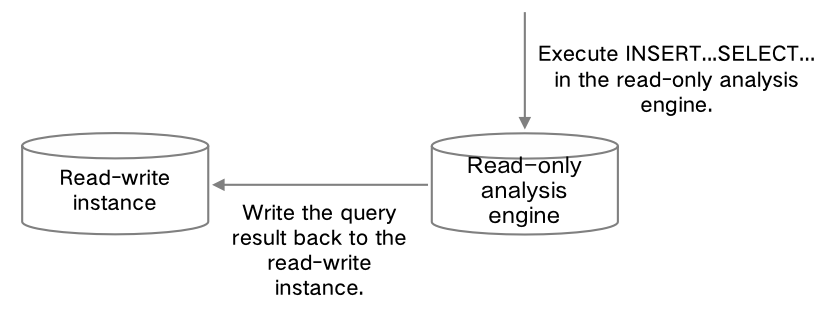ETL Writeback Acceleration
Terakhir diperbarui:2025-03-20 16:04:25
ETL Writeback Acceleration
Terakhir diperbarui: 2025-03-20 16:04:25
In databases, the INSERT INTO <Table> SELECT... statement is often executed. If the execution time of SELECT is too long, the overall execution efficiency becomes low. The read-only analysis engine can handle complex queries in online SQL statements. By using this feature, the SELECT query in an INSERT...SELECT... statement can be executed in the read-only analysis engine to accelerate the SELECT query. The data is automatically written back to the read-write instance, thereby greatly improving the SQL execution efficiency.
Technical Principles

As shown in the above figure, you can execute the
INSERT…SELECT… statement in the read-only analysis engine. The SELECT query will be accelerated by the read-only analysis engine, and the query results will be directly written to the read-write instance, thereby improving the overall execution efficiency.Application Scenario
Note:
This feature applies only to scenarios that are not sensitive to data latency. The read-only analysis engine adopts the asynchronous replication mode. Therefore, a certain time delay may exist between the query results and those in the read-write instance when there is a latency in the read-only analysis engine.
This feature is recommended in scenarios where the query conditions are complex, the SQL statement execution time is long, and the data volume of the query result set is small. In such scenarios, this feature can significantly improve performance because the read-only analysis engine will accelerate SELECT queries.
This feature does not bring performance benefits in all scenarios. Instead, the performance may deteriorate in some scenarios. For example:
When the SELECT query in an
INSERT…SELECT… statement is relatively simple, reading data from the read-only analysis engine and writing the data back to the read-write instance will incur additional network overhead. The strengths are not obvious compared with the method of directly reading data from the read-write instance.When the result set of the SELECT query in an
INSERT…SELECT… statement contains a large volume of data, the main performance bottleneck lies in the process of transmitting the result set over the network and writing it to the read-write instance. In this scenario, this feature cannot be used to improve performance.Apakah halaman ini membantu?
Anda juga dapat Menghubungi Penjualan atau Mengirimkan Tiket untuk meminta bantuan.
Ya
Tidak
masukan